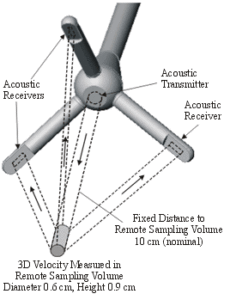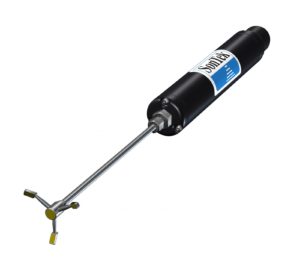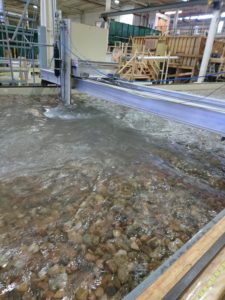Already two weeks have passed! This week was another very interesting week. I wasn’t working on the same project as last week. This week, I got to learn about and help out with the project they call Urban Channels. They had a scale model of the LA channel built in the lab. In the model, they put medium sized rocks in specific spots. Then we would take a device called an ADV(Acoustic Doppler Velocimeter) and measure the velocity of the water around these rocks.
Above is a picture that focuses on the top of the ADV and a picture of the whole ADV. How this device works is you put the three prongs into the water so they are ideally 10cm from the ground. The device then uses the Doppler shift principle to calculate the x, y and z velocities.
They had a system set up where you could move the ADV, the black object in the photo, forward, backward, left and right. You would position it right next to one of the rocks and get the velocity. Another method of finding velocity that I was able to help out with was using PIV(Particle Image Velocimetry). To do this I would set up a GoPro above the whole channel. Then, I would fill a bucket with beads that you find inside of a bean bag. Lastly, while recording I would use a leaf blower to blow the beads into the water for ten seconds straight. The footage that was taken would be transferred to a computer and put into a program that used PIV to calculate the velocity of the water in the whole model. The program would also give back a photo of the model with velocity vectors showing the different velocities.
The projects main purpose is to help fish. When a body of water is low and moving fast it is called supercritical. When water is like this it is really hard for fish to swim upstream. When rocks are added, they cause hydraulic jumps where the water goes backward for a second like in a rapid. These hydraulic jumps help to slow the flow of the water down helping the flow reach subcritical. Subcritical flow is when the water is slower and more stable. This makes it easier for fish to swim upstream. They are trying to find the most ideal positions for these rocks to make swimming upstream easier for fish.
This weekend I found a nice cafe close to my house. It had a bookstore inside that you could take books from and read while you were there. I also played some basketball at a local park. I’m excited for next week at work! Can’t wait to see what new projects there are.




There are no comments published yet.